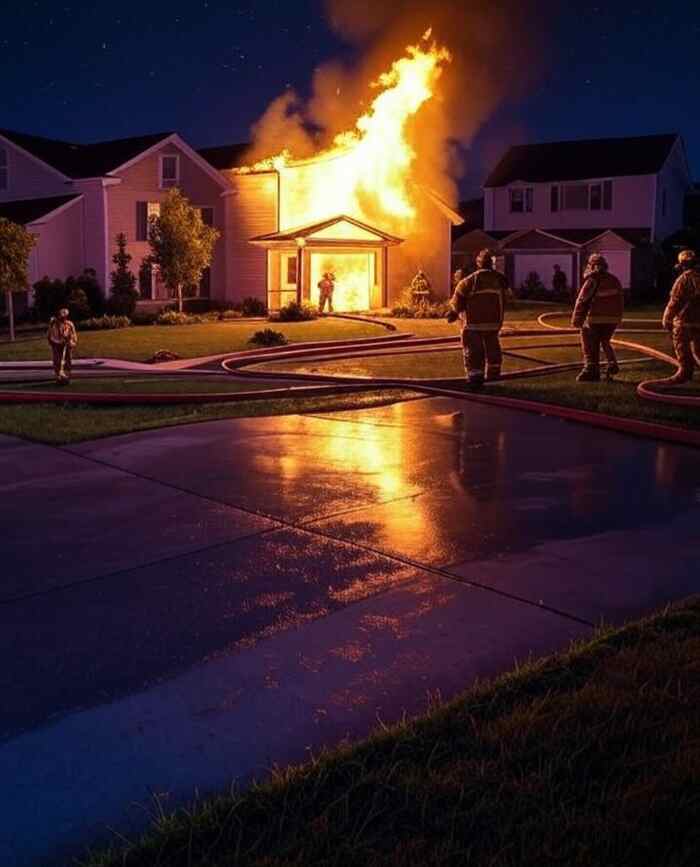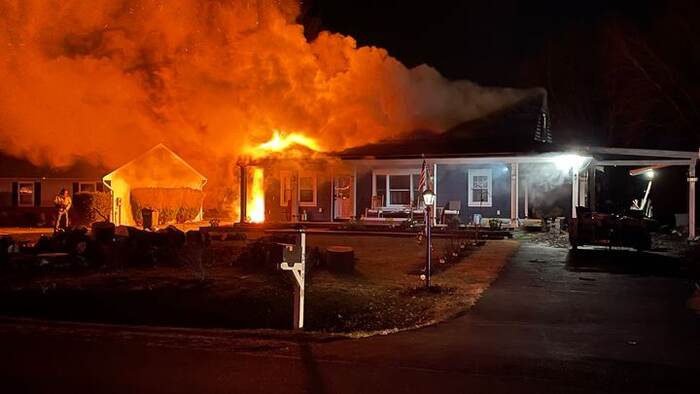Why You Can’t Look Away
A peaceful Sunday evening in Fall River, Massachusetts, took a horrific turn on July 13, 2025, when a deadly fire ripped through Gabriel House Assisted Living. It wasn’t just any blaze—it was a full-blown crisis that trapped seniors, terrified entire families, and forced first responders into a desperate rescue mission.
This is a story of tragedy—but also of hope, resilience, and a community rallying for change. And it begins here.
1. The Night of Terror – July 13, 2025
At 9:50 p.m., flames erupted in one section of the three-story Gabriel House at 261 Oliver Street, sending a column of smoke into the summer sky. Approximately 70 residents lived inside, many of whom relied on wheelchairs, oxygen or had limited mobility. Also, overnight their home became a burning labyrinth.
By the time Fire Chief Jeffrey Bacon and his team arrived, the front was “engulfed in heavy smoke and flames.” What followed was a five-alarm emergency: 50 firefighters (including about 30 who were off-duty), EMS, police, and city resources scrambled to save lives.
Immediate chaos reigned. Residents screamed for help through smoke-filled windows; corridors were pitch-black, lit only by the flicker of flames. In the eyes of first responders, the danger was icy clear: “Smoke kills more people than fire.” — Chief Bacon.
2. Gabriel House Fire: Heroic Moments Forged in Flame
In that rare, high-stakes crucible, ordinary people became heroes.
- Breaking down doors: With no time to lose, officers and firefighters rammed through locked exits to pull seniors into safety.
- Ladders & frantic extractions: Some residents were hoisted out through small windows clogged by AC units; others were carried down ladders by crews.
- The power of unity: Firefighters, police, and EMTs worked side by side—carrying wheelchairs, providing oxygen, and administering first aid—saving dozens.
One EMT described a pivotal moment:
“We pulled people out in their chairs, carrying them down ladders through thick smoke and sprinklers.”
Their courage amid suffocating smoke and streaming heat created a pathway of survival.
3. Lives Altered, Lives Lost
By morning, Fall River was awash in grief. The final toll left nine residents dead—ages 68 to 92—and more than 30 injured, including five firefighters and one critical resident.
Stories that haunt:
- Jarren Oldrid, 35, frantically searched for his father, Steven, who emerged battered but alive.
- Melanie, trapped in her father’s room, called 911 in terror:
“Break the window… I’m going to die in here.”
Moreover, some families endured the worst, awaiting news of loved ones who would never return home. Others found relief, though even survival came with deep psychological scars.
4. Gabriel House Fire: What Saved Lives—and What Failed

In Fact, Gabriel House Fire was unstopable also, had the standard defenses: fire alarms, sprinklers, and a passing inspection as recently as October 15, 2024. But when the minutes counted:
- Did those systems activate quickly—and operate effectively?
- Did broken sprinklers save lives or merely drip helplessly as smoke overwhelmed hallways?
- Were escape routes blocked by AC units, slowing down rescue efforts?
Dr. Elaine Rigsby, a national fire-safety expert, warns:
“Many facilities have systems on paper but fail at actual egress during emergencies—especially for residents with mobility issues.”
The evidence pointing toward systemic flaws gathered within hours: obstructed windows, delayed alerts, and corridors turning into smoke-filled traps.
5. The Unfolding Investigation
In addition, the City, State Police, State Fire Marshal’s Office, and Bristol County’s DA launched a full-scale forensic investigation within hours of the fire’s containment.
They’re now:
- Analyzing fire alarms, sprinkler logs, and smoke detector data
- Testing equipment performance mid-blaze
- Reviewing staff training, evacuation procedures, and past compliance records
Inspector notes show compliance “on paper,” but real-world performance—when lives were on the line—is where this story gets truly unraveling.
6. The Emotional Aftermath: Rallying Around Survivors
With the building engulfed, survivors were rushed to St. Anne’s Hospital and a temporary city shelter. City staff, volunteers, and the Red Cross set up immediate support:
- A family reunification center in the hospital chapel
- Medication continuity and clothing drives
- Emotional and medical counseling on-site
Chief Bacon emphasized psychological care:
“Nobody is programmed to deal with this… seek the help you need.”
Our community, shaken but unbowed, responded with calm urgency—acknowledging that trauma this deep takes time, resources, and care.
7. Turning Tragedy into Reform
Also, too often, tragic flames pass, laws fade, and lessons are forgotten. But this time—something is different.
Moving proposals include:
- Real-time system monitoring, alerting authorities to sprinkler or alarm failures instantly.
- Evacuation drills with mobility-impaired residents conducted quarterly—even nights and weekends.
- Redundant escape routes, like external staircases and zero-obstruction egress planning.
Governor Healey, lawmakers, and city officials have declared this a policy turning point—committing to regulation, oversight, and lasting change.
8. Gabriel House Fire: What You Can Do—Before the Next Crisis
If someone you care about lives in an elder-care facility, here’s your roadmap to safety:
| Action | What to Ask/Do |
|---|---|
| ✅ System Checks | Request copies of inspection and maintenance logs |
| 🚪 Visit & Evaluate | Walk halls after hours—check for clear exits and unlocked doors |
| 🔄 Drill Inquiry | Ask how often evacuation drills happen—do they include non-mobile residents? |
| 🗣️ Training Transparency | Ask staff about their readiness and evacuation protocol |
Each question builds accountability. Each action builds trust—and potentially saves lives.
9. 🔥 Gabriel House Fire: A Community Gripped by Fear and Hope
In the immediate aftermath, Fall River stamped itself as a city teetering between dread and solidarity. As flames died out, survivors—some in wheelchairs, others shaky with shock—were guided to St. Anne’s Hospital and a temporary shelter at the Timao Center. Additionally, families streamed into a chapel-turned‑reunification hub, desperately seeking loved ones.
Jarren Oldrid, 35, shared his whirlwind of relief and fear after finding his father, Steven, suffering from smoke inhalation:
“It’s kind of just a whirlwind of trying to figure out what’s happening, how this could happen in such a major way.”
Nearby, residents like Shirley Cambra, 75, described harrowing minutes before rescue:
“They’re yelling and I couldn’t help. I kept going ‘Wait a minute, wait a minute.”
For many, the situation was surreal. With smoke billowing out shattered windows and doors, a city’s quiet night plunged into chaos.
10. Heroes in Uniform: First Responders Under Pressure
However, fire Chief Jeffrey Bacon—the first official to respond—described a hall filled with thick smoke and frightened residents, some “hanging out of windows looking to be rescued”. Also, it was clear: this was no ordinary blaze.
Nearly 50 firefighters—including 30 who were off-duty—flocked to the scene for a swift, aggressive rescue. Police officers, too, rushed in. As the Fall River PD stated:
“Approximately a dozen non‑ambulatory residents were physically carried out by our officers. Their bravery and quick action undoubtedly saved many lives.”
At least 12 residents emerged via ladders, spirited out of windowed danger zones. All told, more than 30 people were hospitalized, including five firefighters and at least one person in critical condition. Heroism had collided with heartbreak—and the cost was steep.
11. Gabriel House Fire: Smoke, Not Flames, as a Silent Killer
Chief Bacon issued a sobering reminder:
“Smoke kills more people than fire does…listen to your smoke detectors.”
Moreover, this tragedy underscores a hard truth: in elder-care fires, rapid smoke spread often claims more lives than the flames. Dense smoke, thick with toxic particles, trapped residents and created deadly conditions in hallways—all while rescue teams fought tooth and nail for every second.
12. Who Was Affected—and How the Community Stepped Up

Gabriel House, built in 1999, hosts 100 single studios; approximately 70 residents were present when the fire struck. The demographic—seniors with mobility challenges—intensified rescue difficulty and emotional urgency.
Neighbor Joe Alves witnessed the devastation:
“There were people in wheelchairs, a lot of people missing limbs, it was terrible.”
The community response was swift and compassionate:
- A family notification center was set up at St. Anne’s chapel
- City and Red Cross volunteers assisted with medication retrieval, clothes, and emotional comfort.
- Mayor Paul Coogan assured residents, “We’ll do whatever we have to do to help these people”—and pledged to secure alternate housing.
13. Gabriel House Fire The Investigation: Searching for Answers
Investigators—from the Fall River Fire Department, Massachusetts State Police, and Bristol County District Attorney—have launched a comprehensive examination. Key focal points include:
- Timing and functionality of smoke detectors and alarm systems
- Precision and pressure of sprinkler deployment
- Whether window AC units or other obstacles impeded rescue routes
14. Gabriel House Fire: Proactive Reforms in the Making
In fact, lawmakers and state officials are already responding. Governor Maura Healey labeled the incident an “unfathomable tragedy” and pledged full support.
Policy discussions have begun:
- 24/7 monitoring systems that alert authorities to sprinkler or alarm failures
- Quarterly evacuation drills, including dementia-friendly simulations and mobility-impaired evacuation protocols
- Mandates against window obstructions, ensuring every exit is clear and accessible
State-wide inspections are now under way, with several facilities already flagged for potential hazards. This is no longer a theoretical policy—it’s a critical public safety issue sparked by real loss.
15. Healing Beyond the Physical
Fire Chief Bacon reminded everyone:
“Nobody is programmed to deal with this…seek the help that you need to deal with the tragic situation.”
First responders, medical staff, families—they’re all facing emotional trauma. The city has coordinated mental-health debriefs, grief counseling sessions, and ongoing welfare check-ins for all affected individuals.
16. What This Means for You—and What You Can Do
Whether you’re a family member, caregiver, or advocate, use these steps to drive accountability and safety:
- Inspection transparency: Request inspection and maintenance logs from any senior living facility.
- Real-world walkthroughs: Visit during non-business hours and check that exits are unblocked and doors open easily.
- Evacuation preparedness: Inquire about drills—are they happening quarterly? Do they include evacuating wheelchairs or dementia patient scenarios?
- Connect with legislators: Support pending reforms on evacuation protocols and 24/7 system monitoring.
- Share this story: Bring visibility to safety gaps and support community policy change.
Your engagement can help prevent the next Gabriel House tragedy.
17. Faces of Resilience: Personal Profiles from Gabriel House
🌿 Lorraine’s Escape for Air
Lorraine Ferrara, one of about 70 residents at Gabriel House, awoke to the terror of smoke billowing down the hallway. Also, the sprinklers soaked her back, but the choking smoke forced her back into her room. She recalled yelling through the window:
“Help! Help! Second floor!”
A firefighter smashed the window and carried her to safety. Lorraine later shared, “I really thought I was going to die.” These words capture the razor-thin margin between rescue and tragedy.
🔄 Circle of Love: Reunited Fathers and Sons
Jarren Oldrid, 35, searched frantically for his father, Steven, amid the chaos and heavy smoke. By dawn, he found Steven alive in a hospital, suffering from smoke inhalation. Jarren described the ordeal as:
“a whirlwind of trying to figure out what’s happening, how this could happen in such a major way.”
His relief—tempered by disbelief—highlights how trauma and gratitude often travel hand-in-hand.
💔 Gabriel House Fire: A Family’s Unanswered Prayers
In addition, not all stories ended with hugs and tears of relief. Melanie, trapped in her father’s room, called 9-1-1 in panic:
“Break the window… I’m going to die in here.”
Moments later, rescuers reached them—but that desperate plea continues to echo in the minds of caregivers and families across the country.
18. Expert Insights: What Went Wrong—and How to Fix It
🚨 Smoke, the Silent Enemy
Chief Jeffrey Bacon warned: “Smoke kills more people than fire does…listen to your smoke detectors.” In elderly care, fast-spreading smoke is often more deadly than flames. However, that’s why modern safety systems must prioritize early detection and response.
📋 Best Practices According to the Experts
Fire-safety specialists recommend a multi-layered approach. From the McKendree blog:
“Regular fire drills…familiarize residents with evacuation routes”.
They also stress the need for staff training, accessible extinguishers, clear exit signage, and redundant fire-rated barriers.
Architects from Pi Architects added: sprinklers must cover every zone, smoke compartments intact, use of non-combustible materials, and upgraded kitchen safety systems.
In brief, safety must be systematic—not just aspirational.
19. Turning Tragedy Into Legislation: The Path Forward
🏛️ Promises and Policy
Following the fire, Governor Healey pledged full support and resources to Fall River. Now, Massachusetts lawmakers are discussing:
- 24/7 monitoring of fire-sprinkler and alarm systems
- Quarterly evacuation drills for non-ambulatory and cognitively impaired residents
- Ban on window obstructions—like air-conditioners—to guarantee exit access
These aren’t just ideas: inspectors have already begun surprise audits statewide, and at least one draft bill has been circulated.
20. Mental Health: An Undiscovered Casualty
Psychological Wounds Don’t Heal on Their Own
Chief Bacon stated:
“Nobody is programmed to deal with this…seek the help that you need.”
First responders, families, and surviving residents have experienced raw trauma: seeing neighbors trapped, carrying wheelchairs down ladders, hearing SOS calls from windows.
Fall River is now offering debriefings, grief counseling, and ongoing wellness check-ins, facilitated by city services and the Red Cross. Remember—mental scars deserve as much attention as physical wounds.
21. Gabriel House Fire: What Every Family Can Do
Use this section as a definitive guide for safety advocacy.
🔄 Fire-Safety Checklist for Assisted Living Facilities
| Safety Element | Questions to Ask | Why It Matters |
|---|---|---|
| Sprinkler Coverage | “Are all rooms/suites covered?” | These systems stop fires fast—without them, smoke spreads unchecked |
| Alarm & Detection | “Is there real-time monitoring?” | Detectors can fail; alerts must be reliable |
| Obstruction-Free:** | “Are windows and hallways clear?” | AC units and clutter can slow rescues |
| Evacuation Drills | “How often and who’s involved?” | Drills must include night shifts and immobile residents |
| Building Materials & Barriers | “Is the structure fire-rated?” | Compartmentalization slows smoke spread |
| Staff Prep & Training | “Do staff refresh training regularly?” | Proper response saves lives |
| Mental Health Planning | “Is there crisis counseling available?” | Trauma must be addressed proactively |
22. Gabriel House Fire: Your Next Moves
For Families & Caregivers:
- Download our FREE Safety Audit Checklist—tailored for assisted living review.
- Attend upcoming town halls or public hearings on elder-care safety in your region.
- Comment and share this post—your voice matters in shaping policy.
For Facility Operators:
- Schedule monthly test-drills and leak-proof sprinkler system checks.
- Commission a third-party fire safety audit, focusing on window clearance, alarm escalation, and escape protocols.
- Ensure paid counseling services are available for staff and residents.
Community Advocate?
- Support legislation requiring real-time monitoring tech.
- Lobby for funds dedicated to retrofitting older properties.
- Help launch an awareness campaign: info sessions, flyers, neighborhood social posts.
23. Looking Ahead
- Investigation updates from DA’s office expected soon—subscribe for alerts.
- Behavior-change pilot programs being tracked in other states—will Massachusetts follow suit?
- New legislation (like real-time system monitoring) under committee review.
👉 Want to stay at the forefront? Subscribe now for updates on safety audits, legal mandates, and legislative initiatives.
24. Gabriel House Fire Final Thoughts: A Legacy of Protection
The Gabriel House tragedy is heartbreaking—and yet, it could become a turning point for nationwide elder-care safety. It’s a lesson in necessity: fire systems must be multi-layered, buildings must be accessible, staff must be trained, and families must demand transparency.
Every story shared here—Lorraine, Jarren, Melanie—reminds us what’s at stake. Lives depend on more than compliance—they rely on vigilance, compassion, and shared responsibility.
Let’s honor those lost by keeping the conversation alive—and pushing for change that leaves no shadow of smoke unchecked and no vulnerable person unnoticed.

